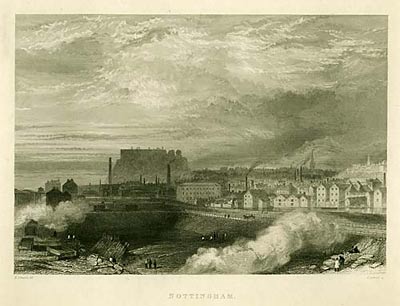Overcrowding and disease
The pressure on space within Nottingham reached its height after 1820. The historian A.C. Wood estimated that of the 12,661 houses standing in the borough in 1841, more than a quarter (3,617) were built between 1821 and 1831. [Source 1]
Two areas of the town which were extensively developed in this decade were the Broad Marsh and Narrow Marsh areas, between the town centre and Leenside. They quickly became heavily overpopulated with fellmongers (who prepared skins for tanners), dyers and scourers, coal-heavers and wharfinger's labourers, stockingers, tanners and bonecrushers. Their homes were built in narrow streets, alleys and courts, lacking street paving, street lighting and adequate water supply, sewerage and all the amenities which make life decent for the citizen of modern Nottingham. Document 1 is a plan of a Nottingham court in the early 1840s.

'Nottingham' by Thomas Abiel Prior (1809-1886), East Midlands Special Collection NOT 1.D14 ALB
Even the land on which these houses were built was itself unhealthy. Blackner wrote in 1815 that the ground was, at best, low-lying and marshy, but that 'nearly the whole of the ground between Turncalf Alley (later Sussex Street) and Bridge Street has been occupied by the tanners and fellmongers' [Source 2], and James Granger recalled watching railway excavations in this area which brought to light the bones and horns of animals and turned up soil 'which would have made excellent manure'. [Source 3]
It is not surprising that such an area was a breeding ground for disease. Overcrowding, poor ventilation, common privies, contaminated and insufficient water, filth, stench and the grinding burden of poverty brought terrible results. Tuberculosis was ever present, carrying off large numbers of children in infancy. Smallpox, typhoid fever, typhus and cholera were intermittent but terrible visitors.
In 1832 a cholera epidemic raged in Nottingham. Significantly, its first victim was a Mr T. Farnsworth of Lees' Yard, off Narrow Marsh. It was mainly among the poor of these court warrens that the disease spread, until it affected some 1,000 people and caused nearly 300 deaths. See Theme 3 of this resource, 'Disease and Death', for more about the cholera epidemics in 19th century Nottingham.
Source 1. A.C. Wood, 'Nottingham 1835-1865', in Transactions of the Thoroton Society, 59 (1955), 1-65
Source 2. J. Blackner, History of Nottingham, p. 210
Source 3. J. Granger, Old Nottingham, Its Streets, People etc., Vol 2 (1904), p.42
Next page: Towards better times